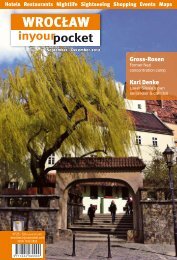SARAJEVO - In Your Pocket
SARAJEVO - In Your Pocket
SARAJEVO - In Your Pocket
Create successful ePaper yourself
Turn your PDF publications into a flip-book with our unique Google optimized e-Paper software.
Ghazi Husrev-beg<br />
Ghazi Husrev-beg B-4, Veliki Saraći, tel. (+387)<br />
33 53 43 75, vakuf-gazi@lsinter.net, www.vakufgazi.ba.<br />
The Gazi Husrev-Beg Mosque was built by the<br />
famous Ottoman architect Mirnar Sinan and is considered<br />
to be one of the most important Islamic buildings in<br />
Bosnia. Gazi Husrev-beg had it constructed by the<br />
Persian architect in an early Istanbul style in 1531. The<br />
45m-high minaret towers over the 26m-high dome and<br />
the surrounding area. The grounds include an abdest<br />
hana, or washing room, a wooden sadrvan (fountain), a<br />
mekteb, or primary school, and a muvekithana, or prayer<br />
caller’s home. To the left are two elaborate 16th century<br />
buildings. The large red house in the enclosed garden<br />
behind the Careva mosque was the official residence of<br />
the Ottoman rulers of Bosnia, and is also the place where<br />
the heavily wounded Archduke Franz Ferdinand and his<br />
wife were brought, and died, after they had been shot by<br />
Gavrilo Princip in 1914.<br />
Jewish Cemetary A-4. Located on the front-line during<br />
the war this historic cemetery was severely damaged<br />
during that time and now faces an ever-present threat<br />
from landslides due to its steep hillside location. Ongoing<br />
rescue and restoration work has seen some of the 3800+<br />
tombstones repaired but much remains to be done and<br />
about 95% of the stones are still damaged. On the site,<br />
located in the Kovačići-Debelo Brdo area and not far above<br />
the transit road, visitors can wander through one of the<br />
largest Jewish cemeteries in Europe. Containing graves<br />
from the 16th century onwards, the cemetery is an integral<br />
part of Jewish history in the region and an atmospheric<br />
and interesting place for the casual visitor though those<br />
wandering through should be aware that the site is in<br />
poor condition and be careful of both the gravestones and<br />
sarajevo.inyourpocket.com<br />
What to see<br />
monuments and their own safety. Also on the site are a<br />
chapel, a fountain and several monuments dedicated to<br />
the victims of fascism. Though it can be walked to and<br />
one can get relatively close by public transport, a taxi<br />
might be the easiest way for visitors who don’t fancy the<br />
steep uphill climb.<br />
Jewish Museum B-4, Mula Mustafe Bašeskije bb,<br />
tel. (+387) 33 21 55 32/(+387) 33 53 56 88, fax<br />
(+387) 33 47 57 49, kontakt@muzejsarajeva.ba,<br />
www.muzejsarajeva.ba. The bare stone walls and timber<br />
floors of this museum, located in a Sarajevo synagogue<br />
built in 1581, provide an aesthetically pleasing space for a<br />
small but well designed and laid out museum dedicated to<br />
the city’s long Jewish history. Along with religious artifacts<br />
the museum displays personal and professional objects<br />
associated with notable local writers, artists, composers<br />
and humanitarian workers. On the upper floor the displays<br />
turn their attention to one of the darkest periods in<br />
human history. The 12000 Jewish Bosnian victims of the<br />
Holocaust are commemorated in a large book bearing<br />
their names while photographs, documents and items<br />
such as concentration camp clothing provide the ‘faces’<br />
behind these names and a testament to their suffering and<br />
the Jewish community’s ultimate survival. QOpen 10:00<br />
- 18:00, Sun 10:00 - 15:00. Closed Sat.<br />
Latin Bridge B-4, Obala Kulina Bana. The name<br />
Latinska Ćuprija may not mean much to the casual visitor<br />
to Sarajevo but mention ‘Franz Ferdinand’ and ‘World War<br />
I’ to anyone who did modern history in high school and the<br />
penny will drop. Dating from 1798 the structure is a fine<br />
example of Ottoman bridge design in itself, but that’s not<br />
why it is world-famous. Latinska Ćuprija is best-known as<br />
the place where the heir to the Austrian throne, Archduke<br />
Franz Ferdinand, and his pregnant wife were assassinated<br />
on 28 June 1914 by a Bosnian Serb nationalist, Gavrilo<br />
Princip. Beyond a plaque at the site and a small museum<br />
nearby little fuss is made of its notoriety but standing here<br />
you are at the place where Princip fired his pistol and where<br />
the rest, as they say, is history.<br />
The pseudo-Moorish Vijećnica<br />
Autumn 2009<br />
31

















